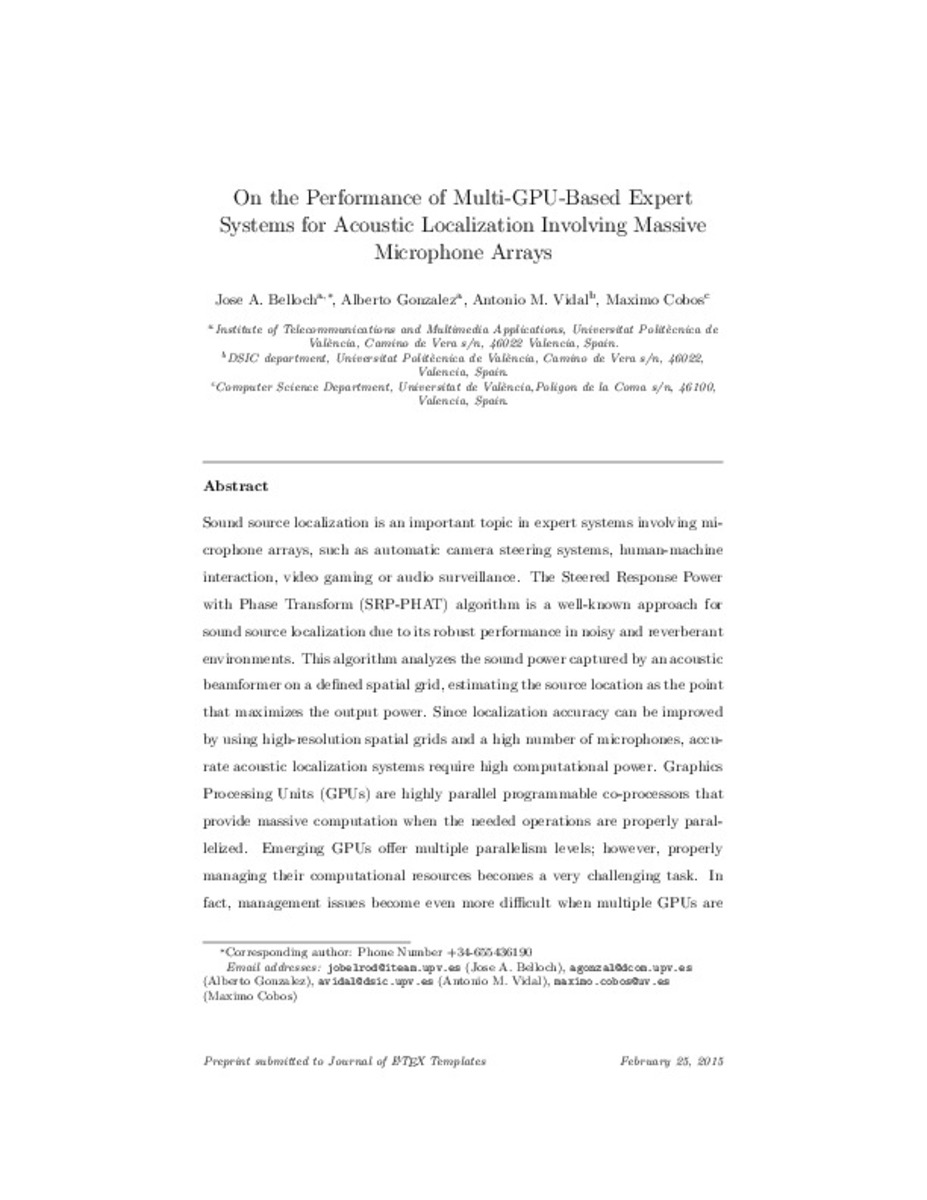Mostrar el registro sencillo del ítem
On the performance of multi-GPU-based expert systems for acoustic localization involving massive microphone arrays
| dc.contributor.author | BELLOCH, JOSE A. | |
| dc.contributor.author | González, Alberto | |
| dc.contributor.author | Vidal, Antonio M. | |
| dc.contributor.author | Cobos, Maximo | |
| dc.date.accessioned | 2016-04-19T12:25:13Z | |
| dc.date.available | 2016-04-19T12:25:13Z | |
| dc.date.issued | 2015 | |
| dc.identifier.citation | BELLOCH, Jose A., et al. On the performance of multi-GPU-based expert systems for acoustic localization involving massive microphone arrays. Expert Systems with Applications, 2015, vol. 42, no 13, p. 5607-5620. | ca_CA |
| dc.identifier.issn | 0957-4174 | |
| dc.identifier.uri | http://hdl.handle.net/10234/158879 | |
| dc.description.abstract | Sound source localization is an important topic in expert systems involving microphone arrays, such as automatic camera steering systems, human–machine interaction, video gaming or audio surveillance. The Steered Response Power with Phase Transform (SRP-PHAT) algorithm is a well-known approach for sound source localization due to its robust performance in noisy and reverberant environments. This algorithm analyzes the sound power captured by an acoustic beamformer on a defined spatial grid, estimating the source location as the point that maximizes the output power. Since localization accuracy can be improved by using high-resolution spatial grids and a high number of microphones, accurate acoustic localization systems require high computational power. Graphics Processing Units (GPUs) are highly parallel programmable co-processors that provide massive computation when the needed operations are properly parallelized. Emerging GPUs offer multiple parallelism levels; however, properly managing their computational resources becomes a very challenging task. In fact, management issues become even more difficult when multiple GPUs are involved, adding one more level of parallelism. In this paper, the performance of an acoustic source localization system using distributed microphones is analyzed over a massive multichannel processing framework in a multi-GPU system. The paper evaluates and points out the influence that the number of microphones and the available computational resources have in the overall system performance. Several acoustic environments are considered to show the impact that noise and reverberation have in the localization accuracy and how the use of massive microphone systems combined with parallelized GPU algorithms can help to mitigate substantially adverse acoustic effects. In this context, the proposed implementation is able to work in real time with high-resolution spatial grids and using up to 48 microphones. These results confirm the advantages of suitable GPU architectures in the development of real-time massive acoustic signal processing systems. | ca_CA |
| dc.format.extent | 37 p. | ca_CA |
| dc.format.mimetype | application/pdf | ca_CA |
| dc.language.iso | eng | ca_CA |
| dc.publisher | Elsevier | ca_CA |
| dc.relation.isPartOf | Expert Systems with Applications, 2015, vol. 42, no 13, p. 5607-5620. | ca_CA |
| dc.rights | Copyright © 2016 Elsevier B.V. or its licensors or contributors. ScienceDirect® is a registered trademark of Elsevier B.V. | ca_CA |
| dc.rights | Attribution-NonCommercial-NoDerivs 4.0 Spain | * |
| dc.rights.uri | http://creativecommons.org/licenses/by-nc-nd/4.0/ | * |
| dc.subject | Sound source localization | ca_CA |
| dc.subject | Steered Response Power | ca_CA |
| dc.subject | Microphone arrays | ca_CA |
| dc.subject | Graphics Processing Units | ca_CA |
| dc.title | On the performance of multi-GPU-based expert systems for acoustic localization involving massive microphone arrays | ca_CA |
| dc.type | info:eu-repo/semantics/article | ca_CA |
| dc.identifier.doi | http://dx.doi.org/10.1016/j.eswa.2015.02.056 | |
| dc.rights.accessRights | info:eu-repo/semantics/openAccess | ca_CA |
| dc.relation.publisherVersion | http://www.sciencedirect.com/science/article/pii/S0957417415001645 | ca_CA |
Ficheros en el ítem
Este ítem aparece en la(s) siguiente(s) colección(ones)
-
ICC_Articles [417]








